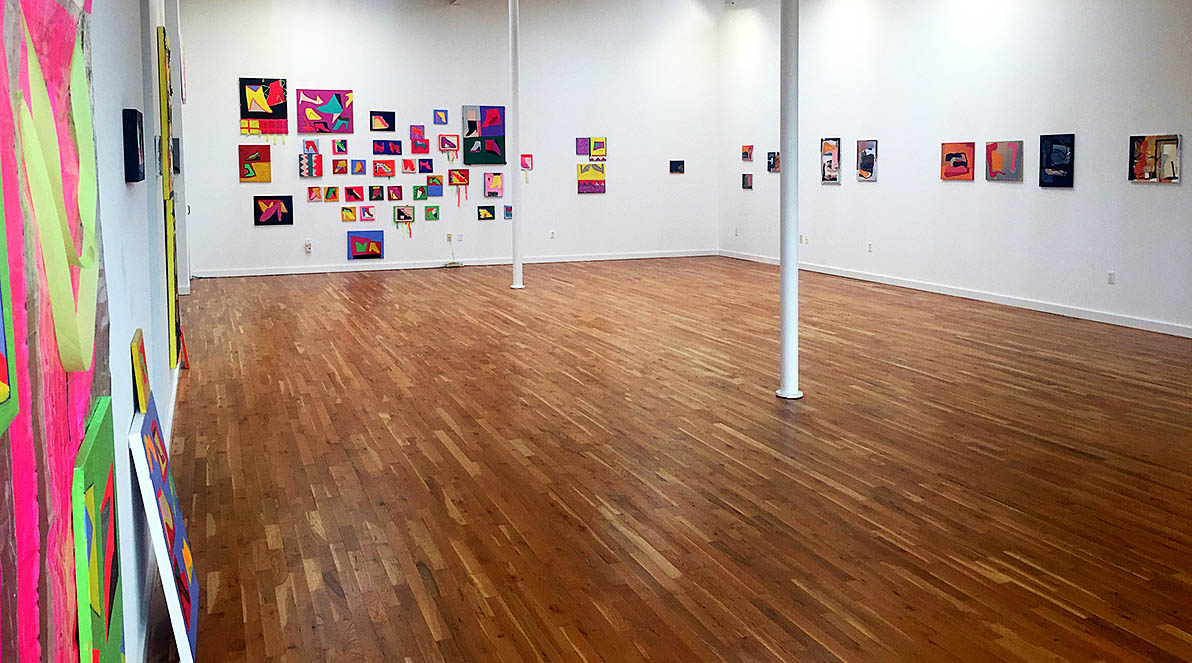
“Sense of Place” installation view; all images by Ryan Standfest
For the inaugural exhibition of the new Hamtramck gallery Nx.ix, gallerist Nicole McIntyre has curated a formally exuberant conversation between the work of Gyan Shrosbree and that of her father Jim Shrosbree. “Sense of Place” presents over 37 paintings in a large, bright, unobstructed space that is extended further as corners, baseboards, hallways, and those places generally left unconsidered in white cube installations, are teased out for a fuller sense of the place itself. Nestled above cabinets, hugging corners and leaning on the floor, groupings of the works into pockets great and small are an echo of what is unfolding within the pieces themselves.
Both bodies of work by Gyan and Jim Shrosbree are from 2019 and were created independently of one another. By bringing them together for this exhibition, Nicole McIntyre has initiated a dialogue in which abundant similarities and contrasts reside, so that the respective languages ultimately challenge each other’s construction. All of the works pursue their own memory by revisiting and revising the very spaces and forms they establish. Each artist in their own way challenges the infrastructure buried within the construction of their images—simultaneously excavating and burying, revealing and concealing. In many of the works, forms find themselves painted and repainted, pulled out, isolated, replaced and interrupted by textures, colors and structural devices intended to both complicate and simplify.
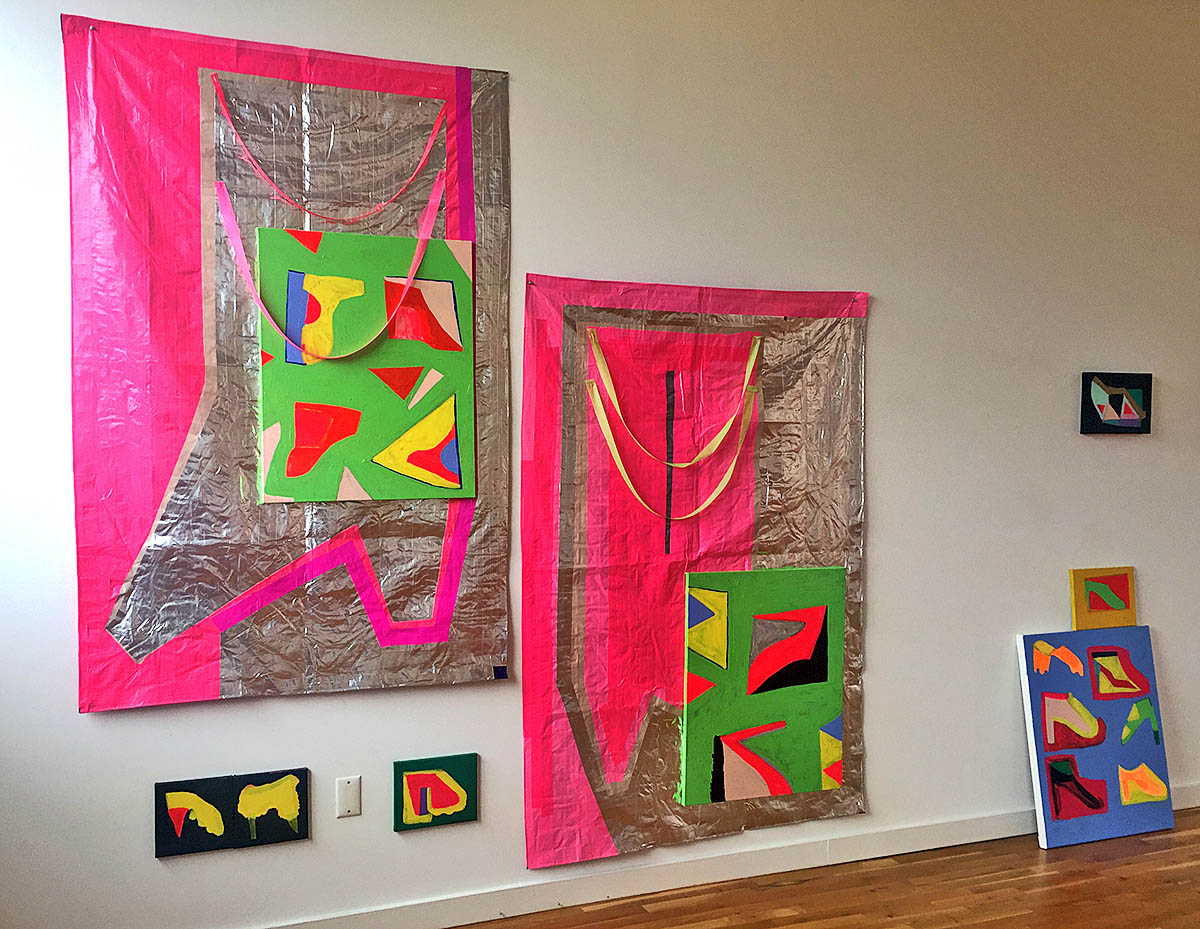
“Sense of Place” installation view: works by Gyan Shrosbree
Gyan Shrosbree employs the recurring image of shoes throughout her work here. And yet they are also not shoes. The image of a shoe is present, but then exaggerated, caricatured, and abstracted into a reductive icon. The association of the shoe nevertheless lingers. That lingering connection with the body results in a proposition for the viewer: how would I need to physically adapt to this new shoe? We exist in a culture of feminine bodily deformation in which shoes bind, constrict and shape physical identity. To draw this conversation into the realm of formal abstraction is not without merit.
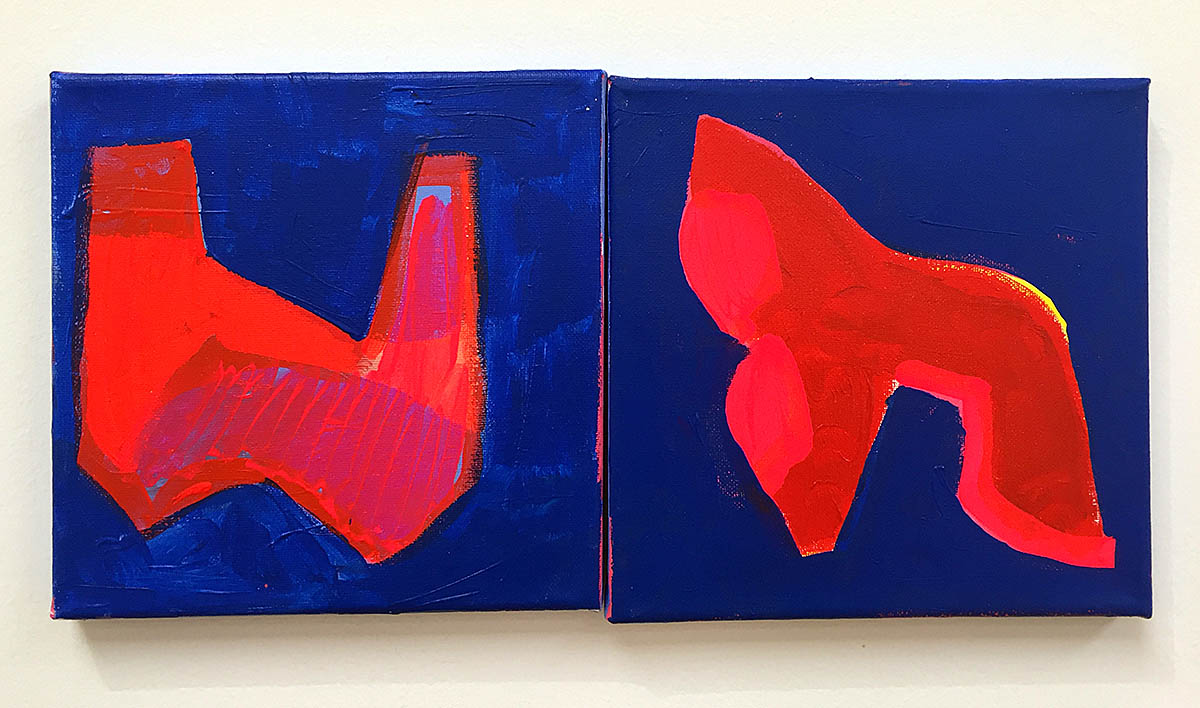
Gyan Shrosbree, detail of “I Will Never Share A Closet With You”, 2019, acrylic on canvas
In the paintings of Philip Guston, shoes are self-contained, heavy and inert things that get heaped and piled. They are abstractions of a shoe—the idea of a shoe arrived at via recollection rather than representation, with emphasis placed on their thick leather soles often upturned and held in place with oversized tacks. Detroit artist Tyree Guyton makes use of the shoe in both painting and installation as the cast-off remnants of a population uprooted, moved, and unmoored, gesturing toward an itinerant homeless life on the street. His large scale paintings of shoes become totemic, celebratory, larger than life street signs reflecting a history of migratory traffic.
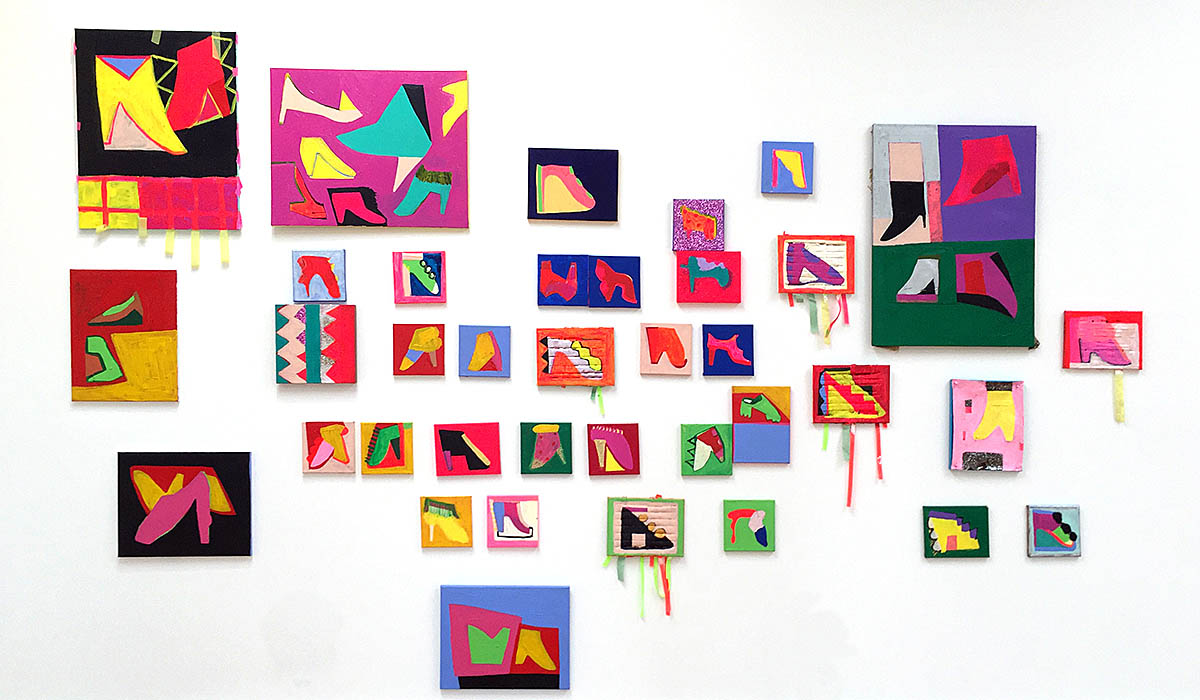
Gyan Shrosbree, “I Will Never Share A Closet With You”, 2019, acrylic, ribbons, glitter, push pins on canvas, various dimensions
From a distance, a grouping of Gyan Shrosbree’s canvases in “I Will Never Share A Closet With You”, suggests a wilder, more organic expression of Peter Halley’s day-glow abstractions from the 1980s. But a closer viewing reveals forms immersed in a folk art, painted sign sensibility. In her work, the shoe serves as a memory vessel, for the foot to return to again and again, always confining to a set shape, to a path taken daily. However, with each return Gyan Shrosbree makes to the body of the shoe, to render it from memory, the shape changes, softens, metamorphoses, allowing for an elastic formal existence. Humorous shapes emerge, and there is an echo of self-taught art, hand-painted signs and memory, in which images are arrived at through recollecting an image and repeating it with the alterations memory gives way to. The compositions suggest the structural rudiments of commercial advertising and merchandise catalogs—both online and printed, with overlapping and adjoining panels for each style. But in these paintings, the commodity grid is also just as fractured as the product. Gyan Shrosbree employs materials that have been associated with lowbrow craft production and the cultural assignation of feminine tastes. The liberal application of glitter, day-glo paint, streamers, and reflective tape signals the opposite of restraint and cranks up the heat in the images. There is a notion of embedded joy in these images. In a work such as “Silver Slippers”, the layering on of such material signals a destabilization of traditional “value”: high art strategies of abstraction are married to low-art techniques of throwing a shiny party. This keeps the work deceptively light, while beneath the skin, deeper structures are being carved up and dismantled.
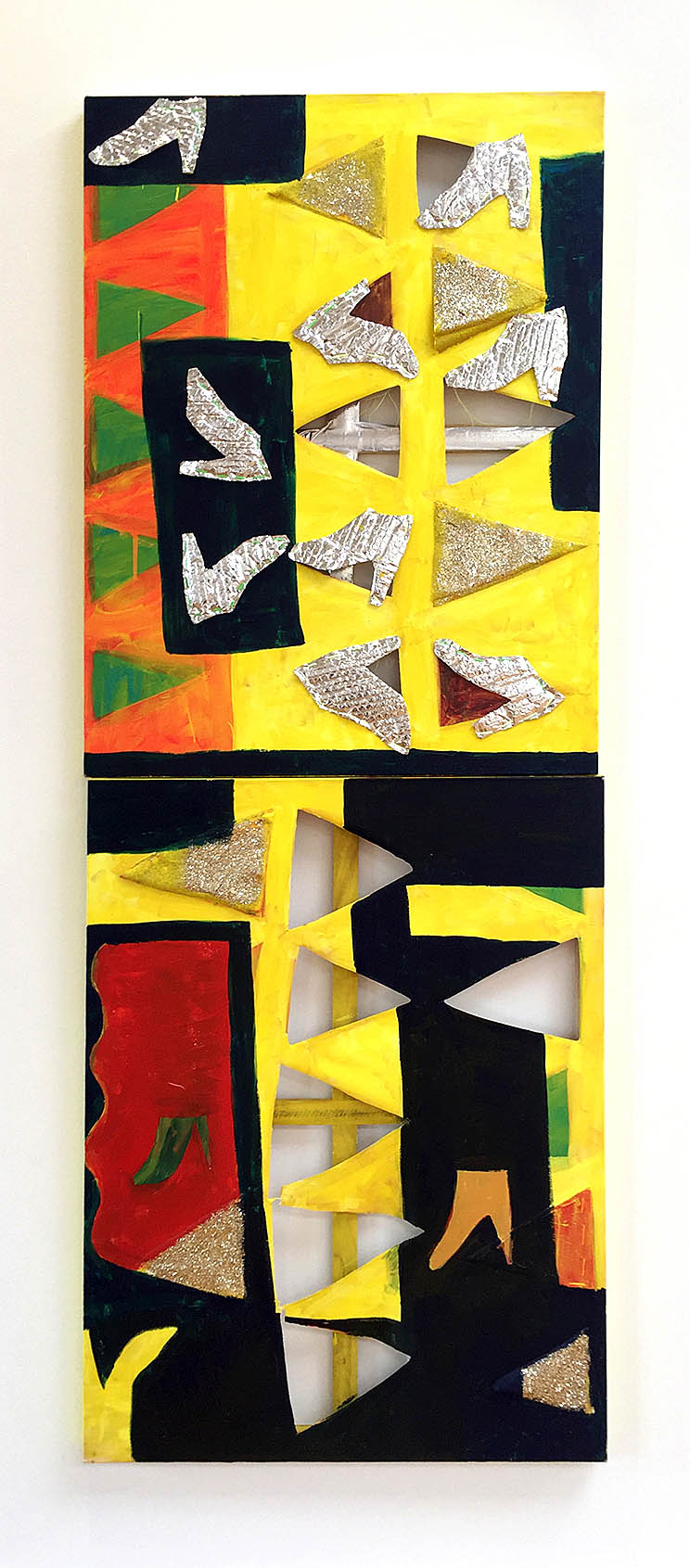
Gyan Shrosbree, “Silver Slippers”, 2019, acrylic, tape, bubble wrap, and thread on canvas, 40” x 30” each

Jim Shrosbree, (left) “Once and Upon (rojo), 2019, oil on canvas, 16” x 20”; (center) “Talla-Hasee (rinse)”, 2019, oil and acrylic on canvas, 16” x 20”; (right) “Finding Out/Looking In”, 2019, oil on canvas, 20” x 16”
With a more subdued palette and a smaller scale, Jim Shrosbree’s paintings in the exhibition explore a process of editing and revising pathways. Moving from the concrete—from finite limitations of language to fragmentation—his spaces toggle between boundlessness and containment. There is a layered history on each canvas—a bit of string and tape buried beneath a skin of paint, a patch of collaged newspaper embedded in a window of pigment allowing us a glimpse of narrative transformed into visual texture. The paint handling moves from thin to thick, dripped to smeared to brushed. Shapes of color on the verge of amorphousness arrive near temporary definition, while pipeline frameworks settle in to add a note of stability.
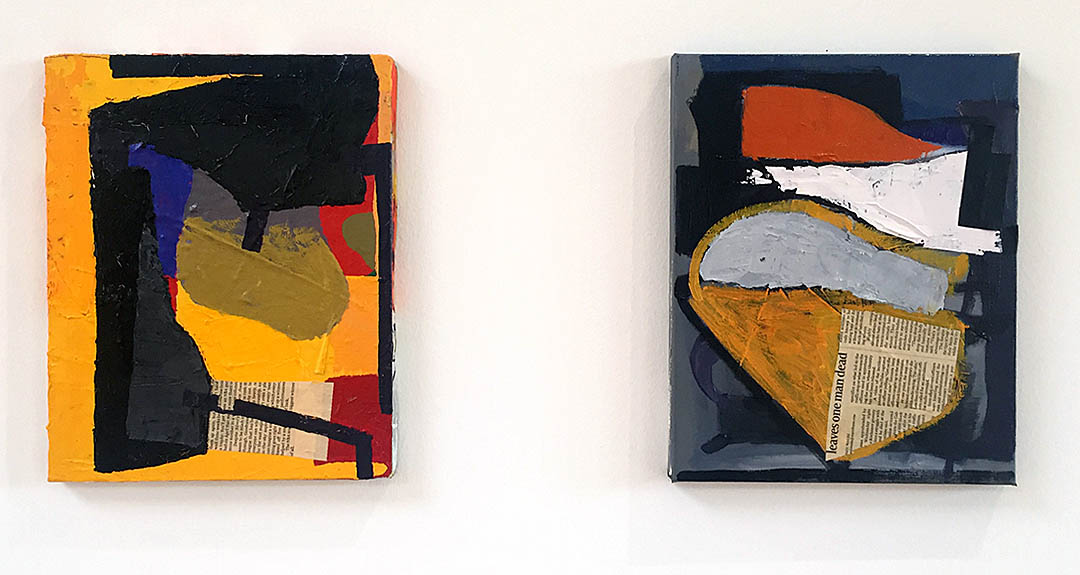
Jim Shrosbree, (left) “Biggest Winner of All”, 2019, oil and collage on canvas, 14” x 11”; (right) “Leaves One”, 2019, oil and collage on canvas, 14” x 11”
Many of Jim Shrosbree’s works here, use collage with newspaper fragments sourced from the Minnesota newspaper The Star Tribune. These shaped clippings—primarily serving a visual purpose with the rigors of functional, readable, black and white text contrasted against the liquidity of paint and color—have the added effect of locating the work as a place. Reading the text to gather every little piece of evidence, can tilt toward a structure. Akin to little scraps of memory, they summon the paintings of the German Dadaist Kurt Schwitters, who would embed used train tickets in his work. Similar to displaying the remnants of daily travel, the newspaper fragments in Jim Shrosbree’s paintings are a glimpse into daily dispatches from a specific time and place. In this sense, his work functions as both a recording and a clouding of that recording. That record is ultimately a memory of the procedures set upon by the painters hand—the accumulated marks and passages that both build upon and eradicate each step taken.
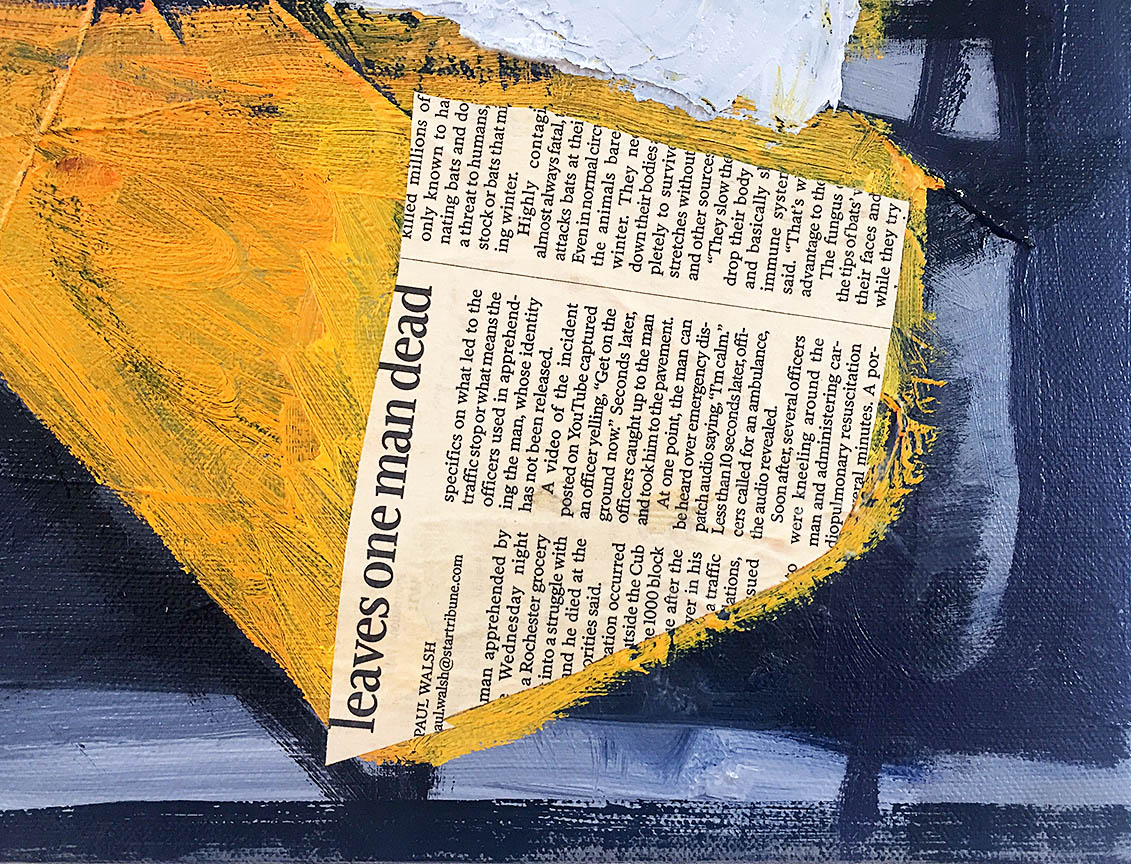
Jim Shrosbree, detail of “Leaves One”, 2019, oil and collage on canvas, 14” x 11”
Taking a stroll from the gallery in Hamtramck down Joseph Campau street, lined with storefronts both vacant and active, there is a resonance with what was experienced at Nx.ix. One passes windows covered over with yellowing newspapers. Another dirty window has stacks of dusty and sun-blanched shoeboxes leaning against it. Hand-painted sales signage in vibrant day-glow colors adorn shop windows. Facades show evidence of older shop names painted over while others are simply ghostly traces of what has slowly faded away.
In Gyan and Jim Shrosbree’s paintings, a sense of place is a sense of one’s place, as we attempt to locate ourselves by constructing a new place in the form of an image, out of and on top of the memory of where we have been. The act of building this new image reflects the ways in which the memories at the foundation of what we are building, complicate and simplify all at once. We abstract prior experiences as they evolve into newly shaped experiences and images. We rework the surfaces and apply a fresh coat of paint to old layers that will eventually resurface to share its history.
“Sense of Place” is on view at Nx.ix Gallery until October 14
